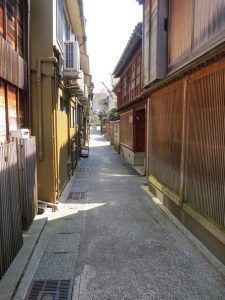We stayed two nights at a traditional Japanese House!
The house was located in the old Kazue-machi district.
From the Kanazawa Tourism site, “Kazue-machi is an old geisha district located along the river between Asanogawa Ohashi Bridge and Naka-no Hashi Bridge”
Walking down a cute/kawaii small alley, we found the house where we were going to stay.
http://en.wikipedia.org/wiki/Machiya
http://www.machiya-kanazawa.jp/english/
Stepping inside there was a small room where you could remove your shoes before entering the house.
Once fully inside, the first thing I noticed was that back in the day, Japanese people were short… I had to duck when moving from room to room since the ceiling was low. I don’t consider myself super tall either, I’m about 6’/182cm.
The kitchen was pretty nice, and clean. Everything was labeled in Japanese and English. I would assume they must get quite a few English-speaking guests.
The bathroom was extremely nice. The sink/toilet/bathroom were all sparkly, as if they were new. I can’t imagine the toilet with its 20 different buttons was very common in the old days, but honestly there are some old-time experiences I don’t feel the need to have. The bathroom being one of them.
No house would be complete without B-chan. The house goldfish, just don’t feed him. I wonder what happens if you did feed him….
I’d like to think that if you did feed him, he would grow to be an enormous giant monster/Kaiju where he would fight in a battle with Godzilla in an attempt to destroy the Earth. But being a good citizen however, I’ll do my part to protect the earth, and let poor B-chan starve.

Previous image from Wiki
We had a little garden to look at through the window. It was nice and pretty relaxing for the brief time I was looking.
While this was mostly decorative, the houses from long ago sometimes came with a tea room, where you would have guests and have a formal tea ceremony.
The floors are made of weaved rice straw/tatami and are pretty comfortable to walk on. I wonder if tatami floors are very delicate, because everywhere we’ve been that have tatami we have had to put our luggage in special areas where the tatami is covered up and we can’t roll bags on it etc.
This would be a place where a geisha could come and entertain with music and dancing.
We setup Futons to sleep on. In one of the closets, there was thick Futon pads that we opened up on the floor, along with sheets, and a comforter.
Early the next morning, the lady that checked us into the hotel stopped by to make us a traditional breakfast. It started with Green Tea flavored rice.
Then there was mushroom soup, potatoes, fu (ya, I had to google it too. Apparently it’s some sort of wheat gluten. I would equate the taste to be similar to soggy bread.), radish, and oranges soggy from being soaked in honey.
I’m guessing mainly for tourists, but yes, they had rickshaws.
Akari zaka – “The light slope”
Kuragari zaka – “The dark slope”
I had to do a little bit of research to understand the significance of these two staircases. This led me to this blog which shed some light:
“If there is something special, I think that should be the narrow sloping streets, Kuragari zaka (暗がり坂) and Akari zaka (あかり坂), that might remind you of geisha’s daily life in this area.
Kuragari zaka (暗がり坂), which means the path in the dark, is a short, narrow slope around the shrine “久保市乙剣宮”.
It’s said that the famous writer in Kanazawa usually went to school via this slope.
As for Akari zaka (あかり坂, 明かり坂), it has an opposite meaning of Kuragari zaka that means the path in the light.
This narrow street was originally nameless but named by the writer Itsuki hiroyuki in his novel.
These narrow streets were the paths for geisha in the past that indicate the social status of geisha.”
Higashi Chaya
While walking a neighboring street which is famous in Kanazawa, Higashi Chaya, we even saw a newly wed couple dressed in traditional clothes. I’m sure they will live happy to know that they will forever be immortalized on this blog. Nevertheless, it was fun seeing the clothes and how they dress.
















Great pictures! Beautiful newlywed attire!